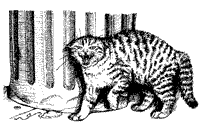|
Feral House Cats | Feral House Cat Overview | Feral Cat Damage Assessment | Feral Cat Damage Management | Feral Cat Resources | Feral Cat Acknowledgments | ICWDM | Wildlife Species Information |
Damage

Feral cats feed extensively on song-birds, game birds, mice and other rodents, rabbits, and other wildlife. In doing so, they lower the carrying capacity of an area for native predators such as foxes, raccoons, coyotes, bob-cats, weasels, and other animals that compete for the same food base.
Where documented, their impact on wildlife populations in suburban and rural areas—directly by predation and indirectly by competition for food— appears enormous. A study under way at the University of Wisconsin (Coleman and Temple 1989) may provide some indication of the extent of their impact in the United States as compared to that in the United Kingdom, where Britain’s five million house cats may take an annual toll of some 70 million animals and birds (Churcher and Lawton 1987). Feral cats occasionally kill poultry and injure house cats.
Feral cats serve as a reservoir for human and wildlife diseases, including cat scratch fever, distemper, histoplasmosis, leptospirosis, mumps, plague, rabies, ringworm, salmonellosis, toxoplasmosis, tularemia, and various endo and ectoparasites.
Legal Status
Cats are considered personal property if ownership can be established through collars, registration tags, tattoos, brands, or legal description and proof of ownership. Cats without identification are considered feral and are rarely protected under state law. They become the property of the landowner upon whose land they exist. Municipal and county animal control agencies, humane animal shelters, and various other public and private “pet” management agencies exist because of feral or unwanted house cats and dogs. These agencies destroy millions of stray cats annually.
State, county, and municipal laws related to cats vary. Before lethal control is undertaken, consult local laws. If live capture is desired, consult the local animal control agency for instructions on disposal of cats.
Economics of Damage and Control
The place of cats in the modern urban world is certainly secure even though their reputation as rodent controllers has not been supported by objective research. Cats have replaced dogs as the most common family pet in the United States. Their owners support a growing segment of the economy in the pet food and pet supplies industries. On the other hand, feral cats are responsible for the transmission of many human and wildlife diseases and kill substantial amounts of wildlife.
|
Feral House Cats | Feral House Cat Overview | Feral Cat Damage Assessment | Feral Cat Damage Management | Feral Cat Resources | Feral Cat Acknowledgments | ICWDM | Wildlife Species Information |
